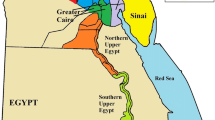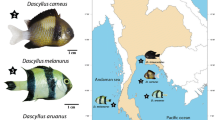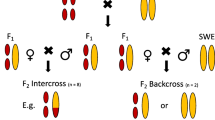Abstract
A satellite DNA family, termed DBC-150, comprises slightly GC-rich repeat units of approximately 150 bp that were isolated (by DNA digestions or PCR) from the genome of all seven Drosophila species from the buzzatii cluster (repleta group). The presence of subrepeats suggests that part of the extant DBC-150 monomer originated by the duplication of small sequence motifs. The DBC-150 family is compared to the previously described pBuM satDNA family, an abundant component of the genome of five species of the cluster. The two families are different in several aspects, including primary structure, A+T content, intraspecific and interspecific variability and rates of homogenization (or nucleotide spread). The data indicate a lower rate of homogenization (and absence of complete concerted evolution) of the DBC-150 compared to the pBuM family. FISH on metaphase chromosomes revealed that the DBC-150 family is located exclusively in the microchromosomes. To our knowledge this is the first record of a complex Drosophila satDNA restricted to a single pair of microchromosomes. The observed low rates of homogenization of the DBC-150 family might be related to a presumed reduction or suppression of meiotic recombination in the microchromosomes.
Similar content being viewed by others
References
Abel LDS, Mantovani M, Moreira-Filho O (2006) Chromosomal distribution of the As51 satellite DNA in two species complexes of the genus Astyanax (Pisces, Characidae). Genet Mol Biol 29: 448-52.
Adams MD, Celniker SE, Holt RA et al. (2000) The genome sequence of Drosophila melanogaster. Science 287: 2185-195.
Bachmann L, Sperlich D (1993) Gradual evolution of a specific satellite DNA family in Drosophila ambigua, D. tristis and D. obscura. Mol Biol Evol 10: 647-59.
Bachmann L, Venazetti F, Sbordoni V (1996). Tandemly repeated satellite DNA of Dolichopoda schiavazzi: a test for models on the evolution of highly repetitive DNA. J Mol Evol 43: 135-44.
Baimai V (1977) Chromosomal polymorphisms of constitutive heterochromatin and inversions in Drosophila. Genetics 85: 85-3.
Baimai V, Sene FM, Pereira MAQR (1983) Heterochromatin and karyotypic differentiation of some neotropical cactus-breeding species of the Drosophila repleta group. Genetica 67: 81-2.
Barragán MJL, Martínez S, Marchal JA et al. (2002) Highly repeated DNA sequences in three species of the genus Pteropus (Megachiroptera, Mammalia). Heredity 88: 366-70.
Bartolomé C, Maside X (2004) The lack of recombination drives the fixation of transposable elements on the fourth chromosome of Drosophila melanogaster. Genet Res Camb 83: 91-00.
Bridges CB (1935) The mutants and linkage data of chromosome four of Drosophila melanogaster. Biol Zh (Moscow) 4: 401–420.
Casals F, Cáceres M, Manfrin MH, González J, Ruiz A (2005) Molecular characterization and chromosomal distribution of Galileo, Kepler and Newton, three foldback transposable elements of the Drosophila buzzatii species complex. Genetics 169: 2047-059.
Casals F, González J, Ruiz A (2006) Abundance and chromosomal distribution of six Drosophila buzzatii transposons: BuT1, BuT2, BuT3, BuT4, BuT5, and BuT6. Chromosoma 115: 403-12.
Charlesworth B, Sniegowski P, Stephan W (1994) The evolutionary dynamics of repetitive DNA in eukaryotes. Nature 371: 215-20.
de Brito RA, Manfrin MH, Sene FM (2002) Nested cladistic analysis of Brazilian populations of Drosophila serido. Mol Phyl Evol 22: 131-43.
de la Herrán, R, Robles F, Cuñado N et al. (2001). A heterochromatic satellite DNA is highly amplified in a single chromosome of Muscari (Hyacinthaceae). Chromosoma 110: 197-02.
Dover GA (1982) Molecular drive: a cohesive mode of species evolution. Nature 199: 111-17.
Dover GA, Tautz D (1986) Conservation and divergence in multigene families: alternatives to selection and drift. Phil Trans R Soc Lond B 312: 272-89.
Fernández R, Barragán MJL, Bullejos M et al. (2001) Molecular and cytogenetic characterization of highly repeated DNA sequences in the vole Microtus cabrerae. Heredity 87: 637-46.
Franco FF, Kuhn GCS, Sene FM, Manfrin MH (2006) Conservation of pBuM-2 satellite DNA sequences among geographically isolated Drosophila gouveai populations. Genetica 128: 287-95.
Henikoff S, Dalal Y (2005) Centromeric heterochromatin: what makes it unique? Curr Opin Genet Dev 15: 177-84.
Henikoff S, Ahmad K, Malik HS (2001) The centromere paradox: stable inheritance with rapidly evolving DNA. Science 293: 1098-102.
Heslop-Harrison JS, Brandes A, Schwarzacher T (2003) Tandemly repeated DNA sequences and centromeric chromosomal regions of Arabidopsis species. Chromosome Res 11: 241-53.
Hochman B (1976) The fourth chromosome of Drosophila melanogaster. In Ashburner M, Novitski E, eds., The Genetics and Biology of Drosophila, Vol. 1b. New York: Academic Press, pp. 903–928.
Kimura M (1980) A simple method for estimating evolutionary rate of base substitution through comparative studies of nucleotide sequences. J Mol Evol 16: 111-20.
Kuhn GCS, Sene FM (2004) Characterisation and interpopulation variability of a complex Hpa I satellite DNA of Drosophila seriema (repleta group). Genetica 121: 241-49.
Kuhn GCS, Sene FM (2005) Evolutionary turnover of two pBuM satellite DNA subfamilies in the Drosophila buzzatii cluster (repleta group): from alpha to alpha/beta arrays. Gene 349: 77-5.
Kuhn GCS, Ruiz A, Alves MAR, Sene FM (1996) The metaphase and polytene chromosomes of Drosophila seriema (repleta group; mulleri subgroup). Brazil J Genet 19: 209-16.
Kuhn GCS, Franco FF, Silva WA Jr, Martinez-Rossi NM, Sene FM (2003) On the pBuM189 satellite DNA variability among South American populations of Drosophila buzzatii. Hereditas 139: 161-66.
Kumar S, Tamura K, Jakobsen IB, Nei M (2001) MEGA2: Molecular evolutionary genetics analysis software. Tempe, Arizona: Arizona State University.
Levinson G, Gutman GA (1987) Slipped-strand mispairing: a major mechanism for DNA sequence evolution. Mol Biol Evol 4: 203-21.
Manfrin MH, Sene FM (2006) Cactophilic Drosophila in South America: a model for evolutionary studies. Genetica 126: 1-9.
Mantovani B, Tinti F, Bachmann L, Scali V (1997) The Bag320 satellite DNA family in Bacillus stick insects (Phasmatodea): different rates of molecular evolution of highly repetitive DNA in bisexual and parthenogenetic taxa. Mol Biol Evol 14: 1197-205.
Navajas-Pérez R, de la Herrán R, Jamilena M et al. (2005) Reduced rates of sequence evolution of Y-linked satellite DNA in Rumex (Polygonaceae). J Mol Evol 60: 391-99.
Pinkel D, Straume T, Gray JW (1986) Cytogenetic analysis using quantitative high-sensivity, fluorescence hybridisation. Proc Natl Acad Sci USA 83: 2934-938.
Powell JR (1997) Progress and Prospects in Evolutionary Biology: The Drosophila Model. New York: Oxford University Press.
Renault S, Rouleux-Bonnin F, Periquet G, Bigot Y (1999) Satellite DNA transcription in Diadromus pulchellus (Hymenoptera). Insect Biochem Mol Biol 29: 103-11.
Riddle NC, Elgin SCR (2006) The dot chromosome of Drosophila: insights into chromatin states and their change over evolutionary time. Chromosome Res 14: 405-16.
Rojas AA, Vazquez-Tello A, Ferbeyre G et al. (2000) Hammerhead-mediated processing of satellite pDo500 family transcripts from Dolichopoda cave crickets. Nucl Acids Res 28: 4037-043.
Ruiz A, Cansian AM, Kuhn GCS, Alves MAR, Sene FM (2000) The Drosophila serido speciation puzzle: putting new pieces together. Genetica 108: 217-27.
Saitou N, Nei M (1987) The neighbor-joining method: a new method for reconstructing phylogenetic trees. Mol Biol Evol 4: 406-25.
Smith GP (1976) Evolution of repeated DNA sequences by unequal crossover. Science 191: 528-35.
Stephan W (1989) Tandem-repetitive noncoding DNA: forms and forces. Mol Biol Evol 6: 198-12.
Stephan W, Cho S (1994) Possible role of natural selection in the formation of tandem-repetitive noncoding DNA. Genetics 136: 333-41.
Strachan T, Webb D, Dover G (1985) Transition stages of molecular drive in multiple-copy DNA families in Drosophila. EMBO J 4: 1701-708.
Sun FL, Cuaycong MH, Craig CA, Wallrath LL, Locke J (2000) The fourth chromosome of Drosophila melanogaster: interspersed euchromatic and heterochromatic domains. Proc Natl Acad Sci USA 97: 5340-345.
Thompson JD, Higgins DG, Gibson TJ (1994) CLUSTALW: improving the sensitivity of progressive sequence alignment through sequence weighting, position-specific gap penalties and weight matrix choice. Nucl Acids Res 22: 4673-680.
Ugarkovic D (2005) Functional elements residing within satellite DNAs. EMBO J 6: 1035-039.
Ugarkovic D, Plohl M (2002) Variation in satellite DNA profiles–causes and effects. EMBO J 21: 5955-959.
Vermaak D, Hayden HS, Henikoff S (2002) Centromere targeting element within the histone fold domain of Cid. Mol Cell Biol 22: 7553-561.
Wheeler LL, Arrighi F, Cordeiro-Stone M, Lee CS (1978) Localization of Drosophila nasutoides satellite DNAs in metaphase chromosomes. Chromosoma 70: 41-0.
Yamada K, Nishida-Umehara C, Matsuda Y (2004) A new family of satellite DNA sequences as a major component of centromeric heterochromatin in owls (Strigiformes). Chromosoma 112: 277-87.
Author information
Authors and Affiliations
Corresponding author
Rights and permissions
About this article
Cite this article
Kuhn, G.C.S., Franco, F.F., Manfrin, M.H. et al. Low rates of homogenization of the DBC-150 satellite DNA family restricted to a single pair of microchromosomes in species from the Drosophila buzzatii cluster. Chromosome Res 15, 457–470 (2007). https://doi.org/10.1007/s10577-007-1138-x
Received:
Revised:
Accepted:
Published:
Issue Date:
DOI: https://doi.org/10.1007/s10577-007-1138-x




